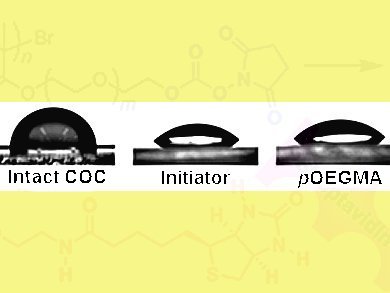Cyclic olefin copolymers (COCs) have desirable physical properties for the manipulation of microfluidic chips, biosensors, and biomedical devices. However, they are not suitable for biotechnological applications because of their hydrophobic character and the lack of reactive groups on their surface.

Korean chemists have tackled such problems by using a method that they term “Biosurface Organic Chemistry”. The team, led by Insung S. Choi, Korea Advanced Institute of Science and Technology (KAIST), Daejeon, Korea, and Jungkyu K. Lee, Kyungpook National University, Daegu, Korea, immobilized an initiator, 2-(2-(2-(4-azido-2,3,5,6-tetrafluorobenzamido)ethyoxy)ethyl 2-bromo-2-methylpropanoate, on a COC by photolysis of perfluoroaryl azide. Surface-initiated, atom transfer radical polymerization grafted a functionalizable, nonbiofouling poly[oligo(ethylene glycol) methacrylate] (pOEGMA) onto the COC. The pOEGMA was subsequently spatioselectively functionalized to generate a biotin-streptavidin micropattern.
The group hopes to extend this technique for funtionalizing other polymer surfaces in the future.
 Polymeric Functionalization of Cyclic Olefin Copolymer Surfaces with Nonbiofouling Poly(oligo(Ethylene Glycol) Methacrylate),
Polymeric Functionalization of Cyclic Olefin Copolymer Surfaces with Nonbiofouling Poly(oligo(Ethylene Glycol) Methacrylate),
Seung Pyo Jeong, Daewha Hong, Sung Min Kang, Insung S. Choi, Jungkyu K. Lee,
Asian J. Org. Chem. 2013, 2, 568–571.
DOI: 10.1002/ajoc.201300078




